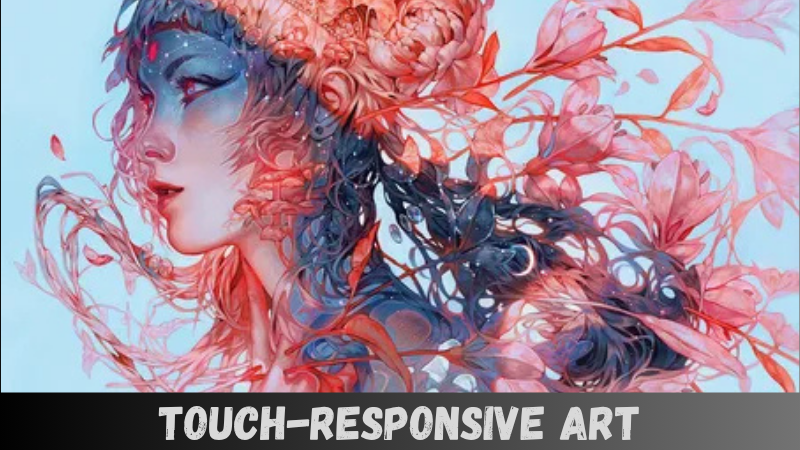Introduction
In today’s ever-evolving art landscape, passive observation is quickly being replaced by immersive engagement. One of the most fascinating innovations in this space is touch-responsive art—an art form that literally comes alive when touched. By integrating tactile technology into traditional and digital mediums, artists can now create works that change, react, or evolve through physical contact. In this article, we’ll explore what touch-responsive art is, how it works, where it’s being used, and why it’s sparking a revolution in modern creativity.
What Is Touch-Responsive Art?
At its core, touch-responsive art refers to artworks that respond to physical contact. These responses might involve changes in sound, color, movement, or lighting—triggered by a viewer’s touch. Unlike typical exhibits that come with “do not touch” warnings, these works invite interaction and exploration.
Common mediums include:
- Interactive walls that light up under pressure
- Sculptures that emit sound when touched
- Paintings embedded with capacitive sensors
- Digital screens or installations that shift based on touch
Ultimately, the goal is to engage the viewer not just visually, but physically and emotionally as well.
How Touch-Responsive Art Works
Artists collaborate with engineers and technologists to embed sensors into or around the artwork. These sensors detect human touch through:
- Capacitive touch sensors (common in smartphones)
- Resistive or pressure-sensitive layers
- Conductive paint or fabric
- Microcontrollers like Arduino or Raspberry Pi
Once touch is detected, the system sends signals to activate responses such as lighting changes, sound playback, kinetic motion, or projection mapping. The result is a work of art that reacts in real-time, making each viewer’s experience personal and unique.
Examples
Around the world, several artists and exhibitions are pushing the boundaries of this medium. Notable examples include:
- “Petting Zoo” by Minimaforms – Robotic tentacles that respond to human touch and movement, exploring emotional interaction between humans and machines.
- “The Pulse Room” by Rafael Lozano-Hemmer – A room of lightbulbs that glow to the rhythm of your heartbeat, detected through touch sensors.
- “The Sensorium” by teamLab – A multi-sensory experience where surfaces respond to touch, sound, and proximity.
These installations demonstrate the emotional power and technical complexity of touch-based engagement.

Why Touch-Responsive Art Resonates with Audiences
Unlike other forms of interactive media, touch-responsive art appeals to one of the most fundamental human instincts—touch. From childhood, we learn through tactile exploration. This kind of art rekindles that curiosity and instinctive connection.
Moreover, the ability to influence and co-create a piece through touch creates a sense of intimacy. Visitors aren’t just spectators—they are participants in the unfolding of the artwork.
This connection is especially meaningful in therapeutic and educational settings, where sensory engagement can improve emotional well-being, memory, and communication.
Applications Beyond the Art World
While stunning in galleries and museums, touch-responsive art is also finding its way into:
- Retail spaces – For interactive displays that enhance customer experience
- Children’s museums and education centers – To encourage learning through touch
- Healthcare facilities – For calming sensory environments
- Tech-based performances – Where touch controls lighting, music, or visuals in real time
These practical applications showcase the flexibility and cross-disciplinary appeal of touch-sensitive design.
Future
- Wearable interactivity, where art responds not just to touch but to gestures or body temperature
- AI integration, allowing installations to learn and evolve with repeated interaction
- Smart materials that change shape or texture on contact
- Augmented reality overlays, combining physical touch with digital enhancements
These developments will further dissolve the boundary between the viewer and the work, making art more alive, more human, and more immersive.
Conclusion
In conclusion, touch-responsive art offers a profound shift in how we experience creativity. By inviting viewers to physically engage with the work, it fosters a deeper emotional connection and redefines the relationship between art and audience. Whether in galleries, public spaces, or educational environments, this form of art challenges tradition and expands our understanding of what art can be in the digital age.
FAQ: Touch-Responsive Art
Q1: What makes touch-responsive art different from traditional interactive art?
A: Traditional interactive art may respond to sound, movement, or environment. Touch-responsive art specifically activates when the viewer physically touches the piece, creating a direct tactile experience.
Q2: Can touch-responsive art be used for therapy or education?
A: Absolutely. It’s widely used in sensory rooms, autism therapy, early education centers, and memory care programs to stimulate cognitive and emotional development.
Q3: Is this type of art only found in galleries?
A: No. Touch-responsive art is also featured in shopping centers, urban installations, hospitals, and interactive advertising campaigns.
Q4: Who are some famous artists working with touch-responsive installations?
A: Artists like Rafael Lozano-Hemmer, teamLab, and Minimaforms have created world-renowned touch-based installations that merge art, science, and human connection.
You may also read this : Projection Mapping Art: Transforming Surfaces Into Living Canvases
